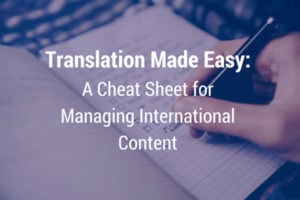Want to streamline your next translation project? Choosing the right translation provider is important, but that’s only half the equation. The other half is up to you! There’s a lot you can do as a client to keep the translation process running smoothly and efficiently, saving time and money in the process.
Help us help you with this handy cheat sheet for managing international content:
KEEP IT SIMPLE.
Use short sentences and short, simple words.
Managing international content begins long before a translator ever lays eyes on it. In general, the easier a piece of content is to understand in English, the easier it is to translate. So, whenever possible, keep it simple.
Is that always going to be possible? Of course not. In certain sectors, it’s impossible to avoid complex terminology. But before you pull out all the five dollar words, ask yourself if they’re truly necessary. Simplify wherever you can.
USE CONSISTENT TERMINOLOGY.
Use the same term for the same concept throughout your international content.
Put away the thesaurus. Stop being afraid of using the same words over and over again. Consistently using the same word for the same concept will make your international content easier to translate.
STYLE GUIDES AND GLOSSARIES ENSURE CONSISTENT RESULTS.
Style guides and glossaries keep everyone involved in the project on the same page.
A style guide ensures that the international content your team produces is clear, precise and consistent across the board. It can also help your translation company better understand and translate your company “voice.”
Meanwhile, glossaries ensure that important terms and words you use on a regular basis get translated into the target language the same way every time.
DON’T BE A WISE GUY.
Humor and jokes get lost in translation.
Have you ever told a joke, and nobody laughed? Awkward! Humor is often quite culturally specific, and wordplay is often difficult to translate. The same goes for slang. Treat it like those “five dollar words” we discussed earlier: if it’s not necessary, take it out.
FORMAT MATTERS.
Both text and graphics should be made available in the correct file formats.
Ideally, both text and graphics should be provided in a format that your translation provider can easily access and edit. Ask your translation company for details.
LEVERAGE PAST EXPERIENCE WITH TRANSLATION MEMORIES.
Translation memories save time and money while ensuring that commonly used phrases get translated consistently.
The more high-quality information your language services provider is able to put into the translation memory system, the more time (and money) you’ll save.
KEEP LAYOUTS FLEXIBLE FOR INTERNATIONAL CONTENT.
Text can expand or contract significantly when translated.
The less time spent redesigning the layout to accommodate the change in size, the better.
COMPLEX CONTENT NEEDS EXPERT TRANSLATION.
To properly understand and translate complex or specialized international content, your translator must often be a subject matter expert as well as a linguist.
For example, if you’re in the legal sector, your translator needs to understand your source language, the target language, and the relevant legal terms for both countries. If you’re in healthcare, you’ll need a translator who understands healthcare terminology.
The bottom line? Look for a translation services company with experience in your field and access to translators who are also subject matter specialists.
The next time you have an international content project on your horizon, use this handy cheat sheet to save time, money and headaches.
And if you’re interested in partnering with a language services company with expert translators and an award-winning project management process, contact us today. We’d love to hear from you!

